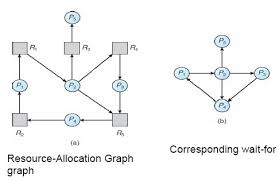Deadlock Detection:
If system does not employ either deadlock prevention or a
deadlock avoidance algorithm, then a deadlock situation may occur. In this environment, the system must provide:
1.
An
algorithm that examines the state of the system to determine whether a deadlock
has occurred.
2.
An
algorithm to recover from the deadlock.
Single Instance of Each Resource Type:
If all resources have only single instance, then we can
define a deadlock detection algorithm that uses a variant of the resource
allocation graph called wait-for graph.
We obtain this graph from the resource allocation graph by removing the nodes of type resource
and collapsing the appropriate edges.
A deadlock exists in the system if and only if the wait-for graph contains a cycle.
To detect deadlocks, the system needs to maintain the wait-for
graph and periodically to invoke an algorithm that searches for a cycle in the
graph.
An algorithm to detect a cycle in a graph requires an order
of n2 operations,
where ‘n’ is the number of vertices
in the graph.
Several Instances of a Resource Type:
The wait-for graph
scheme is not applicable to a resource
allocation system with multiple instances of each resource type.
The deadlock detection algorithm described next is applicable
to such a system. Algorithm has the following data structures:
1. Available: a
vector of length ‘m’ indicates the
number of available resources of each type.
2. Allocation: ‘nxm’ matrix defines the number of
resources of each type currently allocated to each process.
3. Request: ‘nxm’ matrix indicates the current
request of each process. If Request [i,j]=k, then process Pi requesting ‘k’ more instances of resource type Rj.

No comments:
Post a Comment